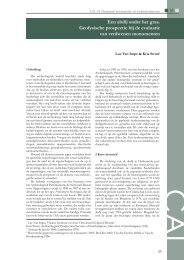Exchanging Medieval Material Culture Studies on archaeology and ...
Exchanging Medieval Material Culture Studies on archaeology and ...
Exchanging Medieval Material Culture Studies on archaeology and ...
You also want an ePaper? Increase the reach of your titles
YUMPU automatically turns print PDFs into web optimized ePapers that Google loves.
the changing relati<strong>on</strong>ships between public <strong>and</strong> private spheres,<br />
is also being carried out <strong>on</strong> the C<strong>on</strong>tinent by scholars from<br />
numerous disciplines158.<br />
3.3 C<strong>on</strong>sumpti<strong>on</strong> <strong>and</strong> Industrializati<strong>on</strong><br />
Initially archaeologists were largely c<strong>on</strong>cerned to date <strong>and</strong><br />
provenance their wares <strong>and</strong> examine problems of technology.<br />
In the last two decades much excellent work has appeared linking<br />
<strong>archaeology</strong> <strong>and</strong> documentary research <strong>and</strong> increasingly<br />
studying producti<strong>on</strong>, distributi<strong>on</strong>, c<strong>on</strong>sumpti<strong>on</strong> <strong>and</strong> discard as<br />
part of a single chain or life history159. Examples of taph<strong>on</strong>omic<br />
analysis (breakage <strong>and</strong> depositi<strong>on</strong>al analysis) of medieval <strong>and</strong>/<br />
or post-medieval fi nds include Françoise Pipp<strong>on</strong>ier’s study of<br />
the fi nds from the deserted medieval village of Dracy in France<br />
<strong>and</strong> Stuart Wrathmell’s analysis of the fi nds from the ditch of<br />
Penhow Castle in Wales; while Stephen Moorhouse has brought<br />
together material from a wide range of British sites160. Much of<br />
the literature <strong>on</strong> post-medieval material culture <strong>and</strong> c<strong>on</strong>sumpti<strong>on</strong><br />
has been generated by the needs of urban <strong>archaeology</strong> to<br />
interpret the enormous quantities of excavated fi nds recovered<br />
from urban excavati<strong>on</strong>s. Recurring topics include supply networks<br />
<strong>and</strong> the problems of interpreting social status of both<br />
households <strong>and</strong> districts161. Other areas of discussi<strong>on</strong> have<br />
included the interplay of such factors as cuisine, trade, technology<br />
<strong>and</strong> fashi<strong>on</strong> in infl uencing changing forms <strong>and</strong> styles162.<br />
Food history is an area cutting across several academic disciplines<br />
but oft en having a material culture element163. Stephen<br />
Mennell’s c<strong>on</strong>clusi<strong>on</strong>s that the post-medieval divergence of<br />
English <strong>and</strong> French cuisine refl ect a complex social <strong>and</strong> political<br />
history rather than diff erences between Catholic hed<strong>on</strong>ism<br />
<strong>and</strong> Protestant puritanism is a warning against superfi cial interpretati<strong>on</strong>s<br />
of cultural diff erences164. Notable for their interdisciplinary<br />
approaches are Kistemaker <strong>and</strong> Van Vilsteren’s edited<br />
volume <strong>on</strong> beer in Holl<strong>and</strong>, Cora Laan’s study of drinking in<br />
18th-century Dutch inns <strong>and</strong> research by Sarah Pennell, Peter<br />
Brears, Fred Kaspar <strong>on</strong> the material culture of kitchens165.<br />
Industrial <strong>archaeology</strong> has been a major sub-discipline not<br />
<strong>on</strong>ly in Britain but also in other European regi<strong>on</strong>s which experienced<br />
industrialisati<strong>on</strong>, notably in France, Germany, Belgium,<br />
Irel<strong>and</strong>, Italy <strong>and</strong> Spain166. Originally, it was mostly an amateur-led<br />
discipline, with an emphasis <strong>on</strong> technical analysis <strong>and</strong><br />
158 Baetens & Bl<strong>on</strong>dé 1991; Leménorel 1997;<br />
Th omass<strong>on</strong> 1997; Kistemaker 2000.<br />
159 Appadurai 1986.<br />
160 Pipp<strong>on</strong>ier 1975; Wrathmell 1987; Moorhouse<br />
1984.<br />
161 Allan 1984; Baart 1990; Th ijssen 1993; Bartels<br />
1999; Brown 1999; Ravoire 2002.<br />
162 Blake 1980; Alex<strong>and</strong>re-Bid<strong>on</strong> 1985;<br />
Goldthwaite 1989; Fayre-Boucharlat 1990;<br />
Verhaeghe 1991; Idem 1999; Gaimster & Nenk<br />
1997; Courtney 1997b; Idem 2004; Gaimster<br />
1998, 115-155; Cumberpatch 2003.<br />
163 Moulin 1989; Anne Wils<strong>on</strong> 1991; Schärer &<br />
Fent<strong>on</strong> 1998; Scholliers 2001; Carroll et al. 2005.<br />
164 Mennell 1985.<br />
165 Kistemaker & Van Vilsteren 1994; Laan 2003;<br />
Pennell 1998; Idem 1999; Brears 2000; Kaspar 1996.<br />
166 Trinder 1993; Berger<strong>on</strong> & Dorel-Ferre 1996;<br />
Represa 1996; Scholliers 2003; Idem 2006;<br />
D<strong>on</strong>nelly & Horning 2002.<br />
167 Palmer & Neavers<strong>on</strong> 1998; Idem 2005;<br />
Newman et al. 2001; Barker & Cranst<strong>on</strong>e 2004;<br />
Casella & Sym<strong>on</strong>ds 2005.<br />
168 Palmer 1990; Idem 2005; Walker et al. 2003;<br />
Cranst<strong>on</strong>e 2004; Casella & Sym<strong>on</strong>ds 2005.<br />
Social theory <strong>and</strong> post-medieval <strong>archaeology</strong>: a historical perspective 325<br />
fi eld recording. Th e last few decades have seen a growth in<br />
industrial <strong>and</strong> eco-museums across Europe <strong>and</strong> in the preservati<strong>on</strong><br />
<strong>and</strong> recording of l<strong>and</strong>scapes threatened by regenerati<strong>on</strong>.<br />
Th is has given the subject a much str<strong>on</strong>ger professi<strong>on</strong>al base<br />
especially in the heritage industry, fi eld <strong>archaeology</strong> <strong>and</strong><br />
increasingly in universities. Industrial archaeologists are also<br />
examining the material culture, l<strong>and</strong>scapes <strong>and</strong> social culture of<br />
industrialisati<strong>on</strong>167. Whether industrial <strong>archaeology</strong> should<br />
remain a thematic discipline, exp<strong>and</strong> into the <strong>archaeology</strong> of<br />
the industrial period or be subsumed into a holistic ‘historical’<br />
<strong>archaeology</strong> studying the period from c.1500 to the present is<br />
a major current debate in Britain168.<br />
Pi<strong>on</strong>eering works looking at the creati<strong>on</strong> of industrial l<strong>and</strong>scapes,<br />
rather than merely industrial units, include a 1975<br />
Belgian exhibiti<strong>on</strong> catalogue, Le paysage de l’industrie169,<br />
Devilliers <strong>and</strong> Huet’s architectural analysis of the new industrial<br />
town of Le Creusot in Burgundy170 <strong>and</strong> various studies of<br />
industrial housing in Engl<strong>and</strong> <strong>and</strong> Wales171. Notable recent<br />
works stressing the social analysis of whole industrialized<br />
l<strong>and</strong>scapes include British studies of Ir<strong>on</strong>bridge Gorge172 <strong>and</strong><br />
Swansea173. David Gwyn has argued for a linkage between<br />
slate worker’s villages <strong>and</strong> blocks of small freehold tenements<br />
in north-west Wales, as large l<strong>and</strong>owners discouraged village<br />
creati<strong>on</strong>174. Barrie Trinder has applied a classifi catory approach<br />
to underst<strong>and</strong> why <strong>on</strong>ly particular market towns industrialized175.<br />
Keith Matthews’ <strong>and</strong> Eleanor C<strong>on</strong>lin Casella’s excavati<strong>on</strong>s,<br />
respectively in urban Chester <strong>and</strong> rural Alderley Edge,<br />
have critically examined the use of material culture by the<br />
Victorian working class176. Gavin Lucas has analysed the social<br />
meaning of transfer-prints using an excavated group of mid-<br />
19th-century ceramics from a Buckinghamshire farmhouse,<br />
especially the short-lived popularity of scenes from the novels<br />
of Sir Walter Scott177.<br />
Permeability maps (access diagrams) have been utilized by<br />
Gary Campi<strong>on</strong> to study the layouts of textile workshops <strong>and</strong><br />
housing in Nottinghamshire, especially to shed light <strong>on</strong> power<br />
relati<strong>on</strong>ships in the industry178. Max Weber’s c<strong>on</strong>cept of social<br />
closure has been adapted by Mike Nevell <strong>and</strong> John Walker to<br />
analyse the relati<strong>on</strong>ship between l<strong>and</strong>ownership, class <strong>and</strong><br />
industrialisati<strong>on</strong> in surveys of archaeological remains in<br />
Tameside, Lancashire179. Th is thesis suggests that new classes<br />
emerge through competiti<strong>on</strong> for ec<strong>on</strong>omic resources then close<br />
169 Wieser-Benedetti 1975.<br />
170 Devilliers & Huet 1981.<br />
171 Chapman 1971; Lowe 1977; Leech 1981.<br />
172 Alfrey & Clark 1993.<br />
173 Hughes 2000.<br />
174 Gwyn 2002.<br />
175 Trinder 2002.<br />
176 Matthews 1999; Idem 2003; Casella 2005.<br />
177 Lucas 2003.<br />
178 Campi<strong>on</strong> 1994.<br />
179 Nevell & Walker 1998; Idem 1999.

















